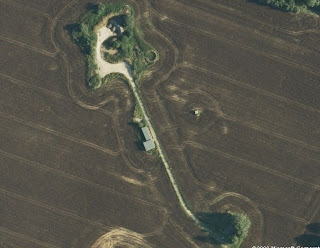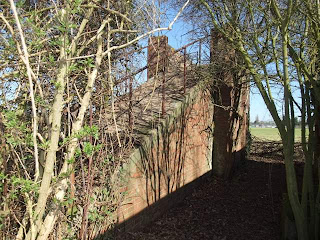This battery was part of the Harwich / Felixstowe AA defences and within the Harwich Gun Defended Area (GDA). The battery was originally armed with four 3.7" guns. Towards the end of the war the site was earmarked to receive 5.25" naval guns (Land Service). The 5.25" was introduced into land service in 1942, with originally twin equipments. Subsequently two types of single gun equipment were developed - one for an AA role and one for a twin AA/Coastal Defence role.
For the first time the following features were available in British AA artillery: electric firing, air blast gear, hydraulic power operated traversing, elevating, loading tray and ramming gears.
It also performed better than the 3.7" guns. Max height range (90 deg) was 55,600 ft (41,000 for the 3.7"); effective ceiling (which is limited by type of predictor and fuse) with Predictor No.10 was 43,000 ft (23,500 ft for the 3.7"); lethal radius of burst for Category A damage (prevention of accurate bombing ) was 100 ft (55ft for the 3.7") and category B damage (failure of aircraft to return to base) was 70 ft (35ft for the 3.7").
Four guns were mounted in concrete lined pits on a Mk 1A mounting. A rectangular open back mild steel shield was provided for each gun. A power house, gun store and shelter were situated below ground adjacent to each gun.
Much still remains of this site including the four gun pits, engine room/stores, command post and radar tower
Image 1: The remains of H2 5.25" HAA Battery
Image 2-4: The Command Post
Image 5: Command post and ramped radar tower
Image 6-7: Ramped radar tower
Image 8: View of battery from top of radar tower
Image 9: Generator room and stores etc
Image 10 & 11: Markers for water and electricity cable
Image 12: Gun pit with attached underground power house, shelter and gun store
Image 13: Gun pit with ammunition lockers
Image 14 & 15: Presumably road blocks, including some at nearby farm. Dimensions do not match that of the standard 'pimple' given in Field Engineering manuals.















Looking through my Mothers war record it records that she was stationed at Trimley as a Spotter for a brief period. I visited the site a couple of years ago and it gave me a funny feeling that my mother walked down this lane, used the site for fighting the enemy!
ReplyDeleteKeith Robinson, Little Oakley, Harwich.